Input interpretation

2 kg of carbon dioxide
Basic properties for 2 kg
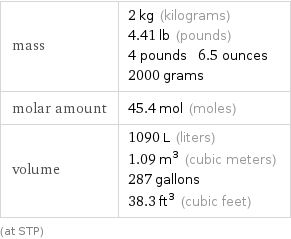
mass | 2 kg (kilograms) 4.41 lb (pounds) 4 pounds 6.5 ounces 2000 grams molar amount | 45.4 mol (moles) volume | 1090 L (liters) 1.09 m^3 (cubic meters) 287 gallons 38.3 ft^3 (cubic feet) (at STP)
Corresponding quantities

sphere radius | 0.637589 meters side of a cube | 1.02779 meters
Thermodynamic properties for 2 kg
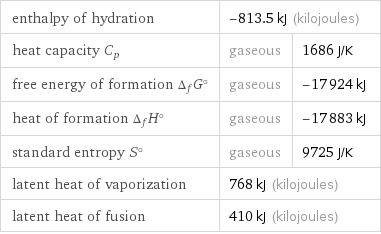
enthalpy of hydration | -813.5 kJ (kilojoules) | heat capacity C_p | gaseous | 1686 J/K free energy of formation Δ_fG° | gaseous | -17924 kJ heat of formation Δ_fH° | gaseous | -17883 kJ standard entropy S° | gaseous | 9725 J/K latent heat of vaporization | 768 kJ (kilojoules) | latent heat of fusion | 410 kJ (kilojoules) |
Units

Energy vs. temperature for 2 kg

(relative to STP)
Units

Phase change energies for 2 kg from 25 °C

energy released from cooling to condensation point | 175 kJ (kilojoules) energy released from cooling to condensation point and converting to liquid | 943 kJ (kilojoules)
Mass composition for 2 kg

C (carbon) | 0.546 kg (27.3%) O (oxygen) | 1.454 kg (72.7%)

Mass composition for 2 kg
Lewis structure
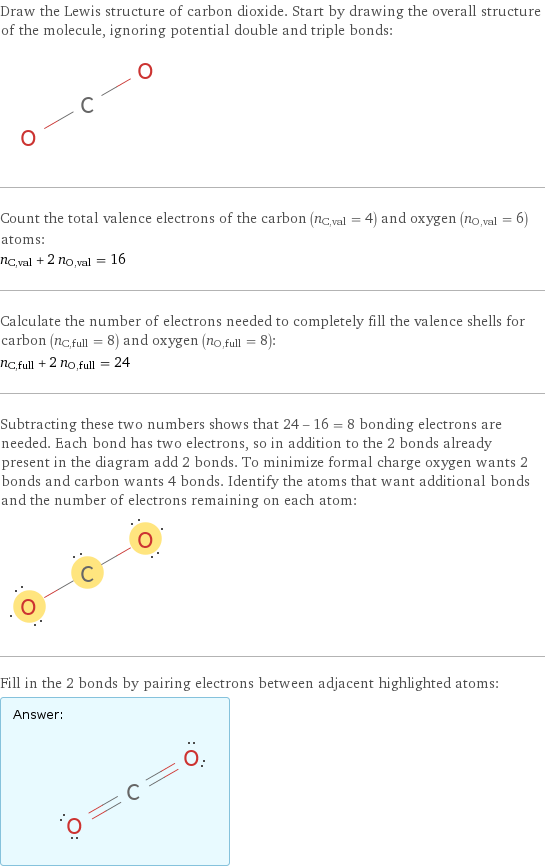
Draw the Lewis structure of carbon dioxide. Start by drawing the overall structure of the molecule, ignoring potential double and triple bonds: Count the total valence electrons of the carbon (n_C, val = 4) and oxygen (n_O, val = 6) atoms: n_C, val + 2 n_O, val = 16 Calculate the number of electrons needed to completely fill the valence shells for carbon (n_C, full = 8) and oxygen (n_O, full = 8): n_C, full + 2 n_O, full = 24 Subtracting these two numbers shows that 24 - 16 = 8 bonding electrons are needed. Each bond has two electrons, so in addition to the 2 bonds already present in the diagram add 2 bonds. To minimize formal charge oxygen wants 2 bonds and carbon wants 4 bonds. Identify the atoms that want additional bonds and the number of electrons remaining on each atom: Fill in the 2 bonds by pairing electrons between adjacent highlighted atoms: Answer: | |
Chemical names and formulas
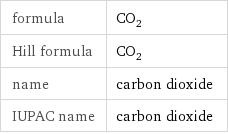
formula | CO_2 Hill formula | CO_2 name | carbon dioxide IUPAC name | carbon dioxide
Substance properties
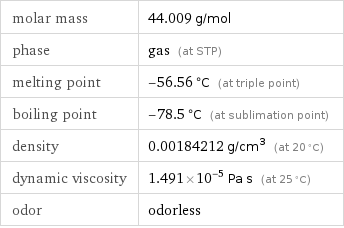
molar mass | 44.009 g/mol phase | gas (at STP) melting point | -56.56 °C (at triple point) boiling point | -78.5 °C (at sublimation point) density | 0.00184212 g/cm^3 (at 20 °C) dynamic viscosity | 1.491×10^-5 Pa s (at 25 °C) odor | odorless
Units

Unit conversion

1/500 tCO_2 (metric tons of carbon dioxide)
Comparison

≈ 1.4×10^(-13) × sustainable carbon dioxide budget ( ≈ 14 GtCO_2 )
Corresponding quantities

Carbon mass m_C equivalent from m_C = m_(CO_2)/3.67: | 5.4×10^-4 tC (metric tons of carbon)

Gas volume V_(CO_2) at standard conditions from V_(CO_2) = m_(CO_2)/ρ_((g), CO_2): | 1.1 m^3 (cubic meters)

Liquid volume V_(CO_2) at the boiling point from V_(CO_2) = m_(CO_2)/ρ_((l), CO_2): | 0.0019 m^3 (cubic meters)